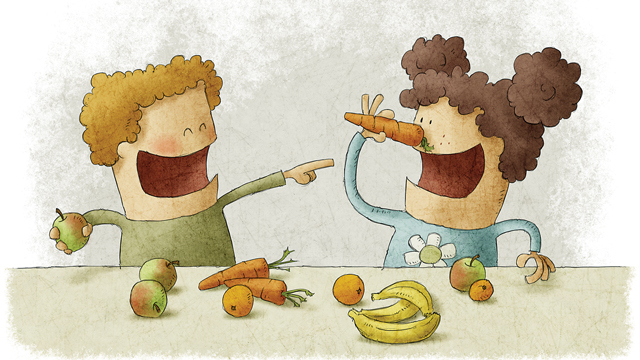Is your child a selective eater? Tips and strategies from parents and experts that will help expand your mealtime options.
When I was a girl, my family traveled about thirty minutes after church each Sunday from our small North Carolina town to the closest city for lunch at Long John Silver’s. The fast-food chain was my dad’s favorite and a staple of my childhood. Before the age of twelve, there was also always a prequel to that lunch. My parents would first swing by the drive-through at the nearby McDonald’s to purchase a Happy Meal for me – a plain cheeseburger and fries with sweet and sour sauce, if you’re curious. I suspect it was a small price to pay for not hearing me complain about never eating yucky fish. When I finally tried fish and chips, of course, it became one of my favorites as well.
Though selective as a child, I’m now one of the most adventurous eaters I know. Given that, I planned to approach parenthood through the lens of adventure. I pictured myself as one of those parents who would have an Instagram feed filled with photos of her children eating fun and exotic foods. Spoiler alert: I was wrong – well, sort of.
I have four children under age eleven. One will try almost anything, one is about 50/50, and two have an assortment of about a dozen foods they rotate. How can it be that four children who are growing up in the same home with the same parents and same exposure to food can be so different? It’s because food is extremely individualized, and what your kids do or don’t eat is not a moral failing, or even a reflection on your parenting.
 Easy Breezy Dinner Plans
Easy Breezy Dinner Plans
No doubt you’ve heard the phrase, It’s not a hill to die on. That pretty much sums up my relationship with eating and my kids. I do my best. I try to offer an array of options, but I’d be lying if I said we sit down to dinner as a family and all have the same meal most nights. My family has two meals that everybody likes – waffles and chicken nuggets with fries. Every other meal is either a hodgepodge, where people have individual meals, or there’s a large meal with at least one thing everyone will eat. That’s the truth and that’s okay – though I’ll admit, it comes with a side of self-doubt and guilt for Mom that I’ll address later in this article. If this sounds familiar, I hope you know we are not alone.
Studies indicate that picky eating is present in 14 to 50 percent of preschool children and 7 to 27 percent of older children. I don’t care for the term “picky.” We use “selective” in my household, but you get the idea, and the meaning is the same. The point is kids have individual relationships with food. We all do. These percentages showcase that eating is not a black and white thing. There is a lot of gray.
One tip that has helped my family is the designation of the weekly super-easy dinner night. In the Brown household, that’s cereal night. Each Monday, which I find is the hardest night of the week for cooking as we get back into work and school routines from the weekend, you pick a cereal you want to eat for dinner. There are rules, mind you. It’s not the Wild West! For example, if you pick a cereal like Cheerios, which has some fiber, is low in sugar, and has at least some protein and nutritional value, you can eat that alone. If you select a more sugary cereal, like Froot Loops, you must pair it with a fruit or yogurt. Furthermore, the milk – which none of my kids have issues with – is a good source of calcium and vitamin D. Cereal night also means there is at least one night a week where we don’t use the stove and leave the table full and happy.
A piece of advice I got from another mother – have a couple of days a month where you let them spoil dinner or eat whatever it is that brings them joy, even if that’s ice cream for dinner. That approach creates a space where over the course of a month, dinner is 98 percent healthy/well-balanced and 2 percent fun, which gives kids something to look forward to.
Expanding the Menu
Eating follows us everywhere and is not limited to a home environment. My husband and I often find ourselves checking online menus in advance to ensure our target restaurant has something everyone can eat. If not, I can stash a few granola bars or peanut butter cups in my purse.
Eating out or ordering takeout can be a way to encourage variety for families. One mom I spoke with suggested exposing kids’ taste buds to multi-cultural menus and food choices as a day-one strategy. One way to achieve that is to have children order off the appetizer menu rather than the kids’ menu. This strategy can hook them early on guacamole and spanakopita, a welcome break from chicken tenders and mac and cheese. This approach might also help reduce selective eating early, and it includes more than just fruits and veggies as options.
The Try-Everything Rule
Sarah Nicholas, a Richmond-area chef, mother, and business owner, recently received her license to become a health and integrative nutrition coach.
“As a person who has had a complex relationship with food for a good portion of my life, it was important to me to try and do it ‘right’ with my kiddos,” says Nicholas. “As a mom, head chef of my household, and kitchen shop owner, food is on the mind constantly, so I decided to dive deep into health and nutrition and form overall healthy habits that allowed me to look at food and my time in a positive way.”

Nicholas says in her household, mealtime changes as seasons and activities change, but her family aspires to sit down for meals close to 90 percent of the time.
“I try and have well-rounded meals and always include at least one thing each person will eat. Our rule is to try everything,” Nicholas says.
She achieves that by not scolding her children or forcing them to sit at the table until they’ve finished every bite, which makes the dinner table a safe space for her boys, who enjoy a range of foods from the typical kid pleasers like chicken nuggets and pizza to some exotic foods and seafood.
“My kiddos don’t see sitting down to dinner as a chore that they have to overcome, and they have fun at dinner time,” Nicholas says. “My motto has always been to make mealtime a fun time, and if they only eat all their veggies five out of seven days, but you get an apple in them each day, it’s okay.”
Nicholas’ advice to other families is simple.
“Don’t try and keep up with the Joneses,” she says, noting that Instagram and Pinterest pages depicting children scarfing down homemade fruit leather and raw carrots can make any parent feel less-than.
Nicholas has also found success letting her kids help in the kitchen and inviting them to be part of the meal-planning process. Like Nicholas, I’ve found success with this strategy, too. Kids are more likely to at least try something they’ve had a hand in creating. Even if they don’t eat it, they become familiar with ingredients and foods that might serve them well in the future. Side note: I did not mention cereal night to Chef Nicholas!
The No-Thank-You Bite
Tara Daudani takes a similar approach when it comes to feeding her two elementary school-age girls, who are big fans of mac and cheese and Indian food.
“We try to provide them with healthy options and put a lot of different choices on their plates,” she says. “We tell them they have to try one bite of everything, and if they don’t like it, they can say no thank you. We call it a no-thank-you bite. That being said, they can’t say no thank you to everything.”
Daudani suggests treading lightly when experimenting with new foods.
“We find if we push too hard, they don’t want to try what we’re offering,” Daudani says. “If we present it as a new cool thing that we like, they usually have no problem trying new foods and sometimes find they like them.”
The no-thank-you bite will soon be introduced in the Brown household.
 The Crudités-First Approach
The Crudités-First Approach
Mother of two Margaret Raigins says her kids gravitate toward white, light, or brown foods – think rice, pasta, potatoes, bread, chicken nuggets, fish sticks, and steak. Does that menu sound familiar? Like Raigins, don’t be too hard on yourself if an array of fruit, veggies, or more colorful options are not included on your family’s kid-friendly menu.
“We thought we were doing an incredible job,” Raigins says, describing how in the early days of parenting, she and her husband could slide just about anything from their plates into their kids’ mouths. “But at whatever time the part of the brain that starts to examine the food kicks in, we ended up with picky eating.”
Her kids struggle with texture preferences, and she says foods that are all mixed together – pot pie, casseroles, and the like – are a strike-out every time.
Raigins had a breakthrough one night when the main portion of the meal simply wasn’t ready in time for hungry tummies.
“I had the veggies and the fruit ready, but I couldn’t get the white and light brown foods on the table quickly enough, so I served crudités first,” says Raigins. “With the promise of their preference coming, I find that my children nibble better on the foods I prefer if I serve them as appetizers to the higher carb meal they really want. This became an unspoken standard practice. Win win!”
I plan to try this in my own household soon. Bonus: You also help your kids learn the meaning of the word crudités – raw vegetables typically served with a sauce.
Professional Insight
Licensed clinical psychologist Janelle Peifer, a professor at the University of Richmond and a mother, has worked with parents and families related to issues around eating.
“So many parents are grappling with their children’s relationship with food, and there is a lot of guilt and shame associated
with that,” says Peifer.

“A lot of parents tie their child’s eating behaviors to their own sense of self, but it’s not that simple,” Peifer explains. “The tricky thing about eating is there are a vast array of individual traits that influence eating that have nothing or very little to do with parenting.”
Peifer says she works with her patients to unpack anxiety and what gets internalized when it comes to food and eating. Oftentimes, this means thinking through the steps that can help a family have more successful relationships with these themes.
“Bargaining and punishing [children] usually doesn’t work and can often lead to further shame or complications,” says Peifer. “I recommend a number of grounding and mindful strategies and refer out [patients] to a feeding expert when needed.”
Peifer says the ultimate goal is a less anxious space related to eating for both the child or children and adults and caregivers. Most importantly, Peifer wants families to know they are not alone.
“Many, many families are navigating a variety of issues around eating and children,” Peifer says. “Parents with children who are adventurous eaters are not better people or better parents. ”
Peifer suggests the following websites, which she describes as clear and non-judgmental for families looking for support: KidsEatinColor.com and FeedingLittles.com.
Raigins, who offered the crudités strategy, is also a fan of Kids Eat in Color.
“As a millennial parent, I trust the account holders with blogs and PhDs, who are engaging with their audiences and answering real questions in real time,” she says. “Their content comes from current clients who they are helping … who are asking questions and their [the content creator’s] need to share the knowledge that they have gained in their area of expertise.”
Obviously, there are tons of online resources and experts in Richmond and beyond on this topic that impacts every family every single day.
If you leave this article with nothing else, please give yourself grace when it comes to your kids and eating. And don’t be afraid to seek advice from other parents or professionals. You are not alone! Whether you institute cereal night, the no-thank-you bite, crudités first, or none of the above, remember that the children out there eating sushi and leafy greens are just as likely to be happy, well-adjusted humans as your kids.
Illustrations: JR Casas




